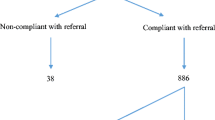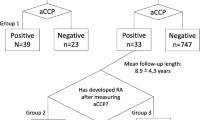Abstract
To ascertain the development of disease in a cohort of connective tissue disease (CTD)-negative patients 10years after testing positive for antinuclear antibody (ANA) in high titer, a telephone survey and serological tests were conducted on a group of CTD-negative patients with high ANA titer identified in a previous study. Thirty-four out of 62 patients (55%) completed only the telephone survey and 27 completed both. The mean length of follow-up was 11.5years. The ages ranged from 27 to 89years with the mean being 58.9years. The sex distribution included 4 (12%) men and 30 (88%) women. Twenty-one out of 27 patients (78%) remained ANA-positive. A total of five patients were diagnosed with CTD with two in the last 5years. Common symptoms described, in order of frequency, were joint pain, Raynaud’s phenomenon, and Sicca symptoms. This study shows that a considerable percentage of CTD-negative individuals with an initial high ANA titer continue to maintain their positivity even after an extended period. It is reassuring, however, that only a small number of these individuals go on to develop CTD. It confirms the fact that the ANA test, despite remaining a useful clinical tool, needs to be used in conjunction with other evidence and clinical judgement when attempting to validate the diagnosis of CTD.
Similar content being viewed by others
References
Hargreaves M, Richmond M, Morton R (1948) Presentation of two bone marrow elements: the ‘tart’ cell or LE cell. Mayo Clin Proc 23:25–28
Myckatyn S, Russell A (2003) Outcome of positive antinuclear antibodies in individuals without connective tissue disease. J Rheumatol 30:736–739
Thomas C, Robinson JA (1993) The antinuclear antibody test: when is a positive result clinically relevant? Postgrad Med 94:55–66
McMCarty GA (1986) Autoantibodies and their relation to rheumatic diseases. Med Clin North Am 70:237–261
Carsons S (1988) Newer laboratory parameters for the diagnosis of rheumatic diseases. Am J Med 85:34–38
Slater CA, Davis RB, Shmerling RH (1996) Antinuclear antibody testing: a study of clinical utility. Arch Intern Med 156:1421–1425
Vaile JH, Dyke L, Kherani R, Johnston C, Higgins T, Russell A (2000) Is high tire ANA specific for connective tissue disease? Clin Exp Rheumatol 18:433–438
Dayan CM, Daniels GH (1996) Chronic autoimmune thyroiditis. N Engl J Med 335:99–107
Vlachoyiannopoulous PG, Tzavara V, Dafni U, Spanos E, Moutsopoulos HM (1998) Clinical features and evolution of antinuclear antibody positive individuals in a rheumatology outpatient clinic. J Rheumatol 25(5):886–891
Acknowledgement
The authors thank Carol Johnston and the staff at the Rheumatic Disease Unit at the University of Alberta Hospital for their assistance in this project.
Disclosures/Conflict of Interest Statement
Neither U. Wijeyesinghe nor A.S. Russell have any conflict of interest.
Author information
Authors and Affiliations
Corresponding author
Rights and permissions
About this article
Cite this article
Wijeyesinghe, U., Russell, A.S. Outcome of high titer antinuclear antibody positivity in individuals without connective tissue disease: a 10-year follow-up. Clin Rheumatol 27, 1399–1402 (2008). https://doi.org/10.1007/s10067-008-0932-y
Received:
Revised:
Accepted:
Published:
Issue Date:
DOI: https://doi.org/10.1007/s10067-008-0932-y




